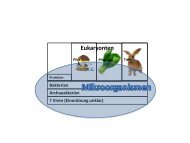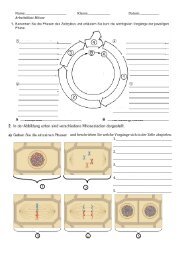Bacteriophages I. INTRODUCTION II. COMPOSITION AND ...
Bacteriophages I. INTRODUCTION II. COMPOSITION AND ...
Bacteriophages I. INTRODUCTION II. COMPOSITION AND ...
Create successful ePaper yourself
Turn your PDF publications into a flip-book with our unique Google optimized e-Paper software.
D. Nucleic Acid Injection - When the phage has gotten through the bacterial envelope the nucleic acid from the head passes through the<br />
hollow tail and enters the bacterial cell. Usually, the only phage component that actually enters the cell is the nucleic acid. Figure 2 <br />
The remainder of the phage remains on the outside of the bacterium. There are some exceptions to this rule. This is<br />
different from animal cell viruses in which most of the virus particle usually gets into the cell. This difference is probably due to the inability of<br />
bacteria to engulf materials.<br />
IV. PHAGE MULTIPLICATION CYCLE<br />
A. Lytic or Virulent Phages<br />
1. Definition - Lytic or virulent phages are phages which can only multiply on bacteria and kill the cell by lysis at the end of the life cycle.<br />
2. Life cycle - The life cycle of a lytic phage is illustrated in Figure 3 .<br />
a. Eclipse period - During the eclipse phase, no infectious phage particles can be found either inside or<br />
outside the bacterial cell. The phage nucleic acid takes over the host biosynthetic machinery and phage<br />
specified m-RNA's and proteins are made. There is an orderly expression of phage directed<br />
macromolecular synthesis, just as one sees in animal virus infections. Early m-RNA's code for early<br />
proteins which are needed for phage DNA synthesis and for shutting off host DNA, RNA and protein<br />
biosynthesis. In some cases the early proteins actually degrade the host chromosome. After phage DNA is<br />
made late m-RNA's and late proteins are made. The late proteins are the structural proteins that comprise<br />
the phage as well as the proteins needed for lysis of the bacterial cell.<br />
Figure 3 <br />
b. Intracellular Accumulation Phase - In this phase the nucleic acid<br />
and structural proteins that have been made are assembled and<br />
infectious phage particles accumulate within the cell.<br />
c. Lysis and Release Phase - After a while the bacteria begin to lyse due to the accumulation of the<br />
phage lysis protein and intracellular phage are released into the medium. The number of particles released<br />
per infected bacteria may be as high as 1000.<br />
Figure 4 <br />
3. Assay for Lytic Phage<br />
a. Plaque assay - Lytic phage are enumerated by a plaque assay. A plaque is a clear area which results from the lysis of bacteria (Figure 4).<br />
Each plaque arises from a single infectious phage. The infectious particle that gives rise to a plaque is called a pfu (plaque forming unit).<br />
B. Lysogenic or Temperate Phage<br />
1. Definition - Lysogenic or temperate phages are those that can either multiply via the lytic cycle or enter a quiescent state in the cell. In this<br />
quiescent state most of the phage genes are not transcribed; the phage genome exists in a repressed state. The phage DNA in this repressed<br />
state is called a prophage because it is not a phage but it has the potential to produce phage. In most cases the phage DNA actually integrates<br />
into the host chromosome and is replicated along with the host chromosome and passed on to the daughter cells. The cell harboring a prophage<br />
is not adversely affected by the presence of the prophage and the lysogenic state may persist indefinitely. The cell harboring a prophage is<br />
termed a lysogen.<br />
[2....]<br />
3. Events Leading to Termination of Lysogeny<br />
Anytime a lysogenic bacterium is exposed to adverse conditions, the lysogenic state can be terminated. This process is called induction.<br />
Conditions which favor the termination of the lysogenic state include: desiccation, exposure to UV or ionizing radiation, exposure to mutagenic<br />
chemicals, etc. Adverse conditions lead to the production of proteases (rec A protein) which destroy the repressor protein. This in turn leads to<br />
the expression of the phage genes, reversal of the integration process and lytic multiplication.<br />
4. Lytic vs Lysogenic Cycle<br />
The decision for lambda to enter the lytic or lysogenic cycle when it first enters a cell is determined by the concentration of the repressor and<br />
another phage protein called cro in the cell. The cro protein turns off the synthesis of the repressor and thus prevents the establishment of<br />
lysogeny. Environmental conditions that favor the production of cro will lead to the lytic cycle while those that favor the production of the<br />
repressor will favor lysogeny.<br />
5. Significance of Lysogeny<br />
a. Model for animal virus transformation - Lysogeny is a model system for virus transformation of animal cells<br />
b. Lysogenic conversion - When a cell becomes lysogenized, occasionally extra genes carried by the phage get expressed in the cell. These<br />
genes can change the properties of the bacterial cell. This process is called lysogenic or phage conversion. This can be of significance clinically.<br />
e.g. Lysogenic phages have been shown to carry genes that can modify the Salmonella O antigen, which is one of the major antigens to which<br />
the immune response is directed. Toxin production by Corynebacterium diphtheriae is mediated by a gene carried by a phage. Only those strain<br />
that have been converted by lysogeny are pathogenic.





